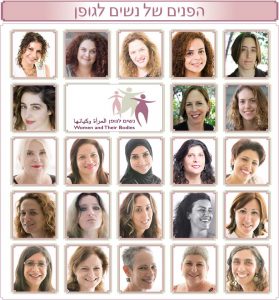Our constant preoccupation with our body and its image accompanies us from childhood in different contexts and to varying extents, depending on internal and external factors. The feminine body comes in an amazing array of shapes and sizes: we are tall, short, thin, fat, strong or fragile. Our eyes come in a range of shapes and colours, our skin in a large rainbow of hues and our hair in many shades and textures. All the same, we are all judged (by ourselves and by others) by irrational standards which create an ideal image of beauty, not achievable by most.
This chapter deals with how our body image affects our lives, how it shapes it and how we cope. Areas of Israeli culture also shape our body image, i.e. army service or local ethnic attitudes regarding the beauty ideal. The chapter ends with cosmetic surgeries that are available to women today and about choosing to change your external appearance in this way. This section includes a critical discussion of all angles, the chances and the risks, as well as information on surgical procedures and much more.
We are never satisfied with our looks; there is always something we would change or fix. Our own bodies are never perfect…
Try to think: how many “real” naked women and men we see in our everyday life? Excluding the seminude or nude people (mostly women) we see in commercials, in fashion magazines, in movies and on television, we hardly ever see “real” naked bodies.
The media creates an “ideal reality”, but the feminine body presented in the media is not a real body. We often encounter the bodies of very young girls or of women after plastic surgery, implants and face lifts, starvation and extreme diets. They always wear heavy make-up and the pictures are touched up and air brushed using computer software. The conceptual distortion is that real women become abnormal as opposed to the women we see daily on the screen or on magazine covers. The beauty role model is unnatural and scarce. It overlooks the beauty within as well as the differences between us.
BEAUTY IS DECEITFUL, AND THE MEDIA IS VAIN
Israeli media is mainly run and ruled by male Ashkenazi Jews who are the decision makers, the sponsors and the directors. Women’s place in the media is fro the other direction, namely posing in a variety of inviting positions for magazine covers, billboards and internet advertisements or as movie and television actresses. The camera tends to presents them as passive and helpless, or as the temptress, instigating evil.
The Gaze Theory
The gaze Theory demonstrates how the camera lens reflects a masculine point of view: the man is shown as active, as the observer, as the one for whom the image is designed. On the other hand, the woman is a passive reflection. Even though she is physically situated in the center of the image, hierarchically speaking she is cast aside. And the man? He looks at the woman with sexual, voyeuristic pleasure, his look making her an his object and at his service. We are accustomed to seeing the world through these dominant male eyes, and therefore hardly notice it. The power of the media causes us to internalize the way men look at women, and how we see ourselves from the outside – as an object.
“HONESTLY, DO I LOOK FAT?”
Beginning in childhood we are intensely occupied with our bodies and our looks in various contexts and levels, affected by different internal and external factors. Our relationship with the mirror is complex, waves of emotions overwhelming us in the course of our life. Almost every woman likes some parts of her body, while judging others as objectionable, unbecoming, imperfect, or simply different from what she wishes them to be. Think: what is the meaning of living inside a body with which we are mostly displeased? Think how much time and effort we put into our looks, and about the frustration these thoughts cause us.
3 more pounds to the moon / Esther Yedgar
You know what it’s like. You sit down on the couch at the end of your workday. You’ve been dreaming of this moment for at least 10 hours. Putting your swollen legs on a pillow, having a cup of coffee, clearing your mind, turning on the TV and escaping.
There you are, in front of the TV; not so thin, a spider vein showing on your leg, gray hair turning up on your head and one on your chin, you’re sweaty and you’re hot, and you wish the wrinkles on the side of your eyes would be from laughing so much, but – how long can you kid yourself. In front of you – flickering on the TV screen – is a chick, a hottie, a bimbo, a model, an anchorwoman. She has a thousand names; you can’t remember what she calls herself. She is all that you are not, she is all that you are supposed to be, she is all that you would ever like to be. Young, thin, blond, pale smooth flexible skin. But you can’t be what she is. Even if you loose some weight and color your hair blond, you will always be dark, oriental, you we never have a thin pelvis or apollonian legs. Your parents come from the wrong continent, and you will never meet these standards. You try to find comfort in thinking that the girl on the screen has no respect for herself. But how consoling is that? She’s not a girl you marry, she’s a girl you take for a night out and she will be twenty forever.
You also know these texts. You have read them a thousand times, in every women’s magazine and every possible feminist position paper. “The Western Enslavement to Beauty – How Dreadful”. You and I know that the model isn’t real, that wanting to look like her is to be unjust to yourself and that you shouldn’t want to be like her. You are an educated woman, you know what’s what, and you understand that there is someone behind all this: advertising agencies, TV channels, fashion designers and so forth. They want you to want to look like her, and you for some reason believe them. You know it’s a lie but you can’t bring yourself to quit. The beauty ideal is made up of thin young women who don’t work hard, who can afford buying products far out of your reach, who meet the physical criteria you can never meet. The Israeli beauty ideal is based on origin. It is a derivative of the Western beauty ideal that does not embrace a spectrum of beauty, only white beauty. Due to physiological reasons oriental women cannot be a part of the competition. Our starting point is inferior because of our genes. We are darker, wider, not sufficiently milky-white. We are shut out of the game and receive a consolation prize – a promise that if we just loose a few pounds, we can get back in the game. We are always just barely in sight; even in commercials oriental women get close-to-lead parts so that we think we are on the verge of existence, on the verge of having a part in the game. Not to say that Ashkenazi women are automatically allowed to participate in this game. They too suffer the same exclusion we suffer, but at least they exist. To these women I can offer some consolation – perhaps we both wear these few extra pounds, but at least your skin is the right color.
So if we know it’s a lie, why do we still believe it?
It has been argued that we women tend to keep everything inside. Perhaps we also tend to do that when it comes to violence. We direct the violence inwards, towards ourselves. Wanting to be someone you are not is not accepting yourself. Does self-hatred sound familiar? What is self-hatred if not violence towards myself? The immediate expression of violence directed inwards is feeling uncomfortable inside my own body, not accepting myself. We are like tourists inside own our bodies, always living in a borrowed body: before long it will transform into a thin lovely well-built body, and then I will be seen as I really am. My boss will know that I am a woman, a person, and that I have an opinion worth hearing. Just 3 more pounds and I will be heard.
On the other hand, men are taught by society to direct violence outwards. Some beat up women, some drive violently on the road, and most of them play soccer. They also know how to make time for themselves. Regardless of how the house looks, they will always find the time to play basketball with the guys. And you? You never make time for yourself, you don’t play soccer, and you drive as if the road embarrassed you. Where does your anger go? Inside. You are angry with yourself. Your daily exhaustion and pain and your existential anxiety accumulates into the illusion of an escape through a physical change. You are violent towards yourself. Anything you don’t have the nerve to say to the world, you say to yourself. Just a few more pounds and everything will be alright.
We generally begin life feeling comfortable with our bodies. As youngsters we learn to discover the world through our bodies. However, as we get older we tend to feel less and less “at home” inside our own skin. Only a few of us continue to feel comfortable with their bodies as they mature.
YOUNG GIRLS AND THEIR BODIES
Growing up is a process that each and every one of us goes through in her own individual way and at her own individual pace. The body significantly changes between the ages of 8 and 17: some become more rounded, some grow taller, and others experience early development of breasts. One feels the hormones flowing through her body and mind while the other doesn’t. Most girls have a hard time getting used to the changes their bodies go through and to the way their bodies look and move. Adolescence can put individuals under a lot of pressure, because during that period girls are more sensitive and easily influenced by their environment and the culture in which they live. This influence might be harmful and confusing when it comes to the shaping of our body image. The influence of our peers grows stronger and so does the influence of our role models on television and in the movies, in commercials and on the internet. Commercial companies in the beauty industry are aware of the fact that girls at this age are intensely occupied with their bodies, and make their fortunes out of the aspiration for a perfect body.
Female soldiers’ body image / Orna Sasson-Levy
The Israeli military body is a male body. A masculine, healthy, strong body is the primary requisite for serving as a combat soldier. This is the body, the model, with which all other male and female soldiers’ body image aligns.
Female soldiers’ body image is not uniform or stable, but rather it varies according to the soldier’s job, the army base she serves in, her social environment and her distance from the combat soldier. It is therefore impossible to characterize the female soldiers’ body image, and there is need to approach the issue in a pluralistic view and talk about the various body images of female soldiers. These images are closely related to the different jobs the soldiers have.
Female soldiers who serve in “masculine” or combat jobs, as infantry instructors or as border police officers (2.5% of the female soldiers serve as combat soldiers) adopt and imitate the physical practice of the combat male soldier: they learn to walk like him, dress like him, talk and even think like him. “I remember myself in infantry instructor training… they teach you a masculine walk, a fast walk. In the beginning the company commander walks that walk, and you run after him because you can’t keep up with his pace. In time you learn to walk like him and you stop running.” Or as a basic training officer put it: “If you had seen me in the army you wouldn’t believe what you see today, two completely different things. I looked like a guy. Because you’re walking around with fatigues, so it’s very awkward, you don’t wear tight flattering uniform, and you carry a firearm, so you’re very clumsy, and your tone of voice is lower; I wouldn’t talk to him like this [in a normal voice], I would talk like this [uses a low voice].” When female soldiers adopt the male combat soldier’s body image an ambivalent feeling is planted in them: on the one hand they develop an active body image which emphasizes capability, acquiring new abilities and physical confidence. On the other hand, their bodies stay feminine, and as such their body is the eternal “witness for the prosecution” against complete integration of women in the army.
On the other side of the military continuum are many, at least one third, female soldiers who serve in various administrative jobs. Doing these jobs the soldiers, fixed in front of a desk and surrounded by four walls, idly get bored. In one interview, one of the interviewees, a clerk, told me what she was about to do once the interview was over: “Just like now… sit with my legs crossed and think how am I to pass the time”. Many clerks have talked about the custom of keeping them in the office until the officer tells them they are free to go. “What do I do until 12 o’clock at night? I play solitaire and he invites his friends for coffee at the maintenance office.” The body image of these soldiers is shaped as the opposite of the combat soldier’s body image: a passive, fattening, idle body. The physical boredom joins the mental boredom, they maintain each other; and the low self esteem is linked to a negative body image.
How can we help our daughters foster a more positive body image?
Those were the days… we were once teenagers. Do you remember how hard it can be sometimes? How you used to strictly test every inch of your body, how you used to harshly criticize yourself and your body? It seems every teenage girl has difficulties accepting her own body. These difficulties tend to persistently accompany us throughout life, and sometimes it is very hard to free ourselves from their grip. Our feminine body image is largely shaped in these fragile years. How can we mothers help our daughters or sons in this context? How can we play an active role and help our children foster a positive body image?
Here are a few suggestions for encouraging a more positive body image in our children. Note that the suggestions talk about our daughters, but are equally applicable to our sons too.
Let’s start with ourselves: ask yourself do you set a good example for fostering a positive body image? The messages we give our daughters affect them, sometimes even more than the media does. The sad truth is that many girls learn to hate their bodies by imitating their mothers. We should notice how we speak of our bodies with our daughters, our friends, and our spouse. How much time do we spend daily talking about our looks, clothes, diet or weight?
- From time to time, watch a movie, a commercial or a TV program with your daughter. Talk about the characters; help her notice stereotypes and the point of view of the people “behind the camera”.
- We can encourage a more positive body image by teaching our daughters to focus on health and not body weight, by encouraging them to exercise in a fun activity and to plan and prepare healthy meals together. It is advisable to initiate conversations regarding the social messages that shape the “desirable body”, the distance between the actual and the desirable and the price we might pay while trying to achieve that ideal. Try to listen and not judge the way they talk about their selves and their bodies, and look for changes in their eating habits.
- Fostering a positive body image is also linked in various ways to self-perception, especially with our daughters. Try directing them towards the search of personal strength based on achieving one’s dreams and goals, and not just based on their beauty. If we enable our daughters to define their own values and fields of interest, help them live by these values, encourage them to stick to their opinion and listen to their inner voice, we can help them build their selves into independent complete women.
- Most of us have inner voices that accompany us with every bite. Let’s release ourselves of that soundtrack, indulge our passions once in a while with the things we love to enjoy, without feeling guilty.
- Instead of being passive consumers, we can use our purchasing power. A consumer embargo can work if we are decisive. The embargo on cellular companies resulted in a reduction of call prices, and an embargo on the SuperPharm chain led to a change in policy that allowed the cashiers to sit down during their shifts. If we use our purchasing power wisely, we can also make a change…
- Trying a new kind of exercise or other physical activity (such as dancing or martial arts) that we have yet to try is recommended. Physical activity helps us appreciate our body and our strength, and learn to know it better. This is how we learn to appreciate what our body can do instead of being preoccupied only with its appearance.
WOMEN AND THEIR MATURING BODIES
During pregnancy, birth, and in most cases after giving birth, our bodies change and reveal our maturing femininity, leaving our youth behind. Israeli women are in a sense between a rock and a hard place – on the one hand the Israeli society sanctifies motherhood and the idea that motherhood is the ultimate realization of femininity; on the other hand, the glorification of skinniness and youth drives women into an impossible Sisyphean struggle with their evolving bodies as a result of the long- awaited motherhood.
In a society that worships youth and skinniness, we find it hard to accept and love our changing bodies, to learn to appreciate the trails signifying our travel through the cycle of life.
Maturing, a natural process, is considered a process that should be prevented, stopped, treated and even cured, as if it were a disease. Very often technology provides us with various new “Anti-Aging” products, establishing the illusion that if we just give it the right amount of work, we will acquire everlasting beauty and youth. The pursuit after youth and beauty prevents some of us from seeing the beauty of maturity and old-age. Many cultures admire and respect the beauty and wisdom of their elders (for example: the Jewish, Native American, Chinese and Polynesian cultures). These perceptions present the years gone by and the maturation as bestowing a rich life experience, honor, wisdom and clear judgment.
ONCE A “BOMBSHELL”, NOW A “MANATEE”
In everyday life we are referred to with various names focusing on our looks, be it when we walk down the street, go to the grocery, or at the playground. The name continuum begins with beautiful and ends with ugly, and these names affect our body image and self esteem. We are categorized as very beautiful (hottie, foxy, sexy, milf, chick, stacked), average or ordinary (nothing special, second rate), ugly or fat (dog, whale, butt-ugly, hideous, manatee). Our body parts also receive various names, independently, as if autonomous organs: knockers, fun bags, honkers, melons (or other types of fruit, depending on the size).
Women in general, and our vagina in particular (“what’s that matter, are you a pussy?!”), are perceived as negative. Most curse words use names and words regarding women and their vaginas, be it mothers, sisters or spouses.
WOMEN’S BODIES IN THE EYES OF SOCIETY
Most cultural works of art emphasize beauty as the most important feature of women and ties between beauty and positive “feminine” characteristics such as tenderness and pleasantness. Boys and men are defined using various “masculine” characteristics: tough-guy, go-getter, mischievous, and sophisticated.
We all experience these social messages in our daily reality: messages we receive on the street, at work, at home or at school regarding the importance of perfect looks are often accompanied with offending or degrading comments about our nose, breasts, legs, buttocks or bodies; we sometimes see these messages with sarcastic eyes in an effort to nullify them, and at other times we are flattered by them. However these messages can sometimes become invasive, violent acts such as sexual harassment and abuse; others can also be sexual assault, sexual violence and rape, events which many of us experience throughout life.
In our modern world we are surrounded and flooded with commercials, overt or subtle. Many of us believe ourselves to be immune to the effects of commercials, and this common mistake is one of the major reasons for the tremendous effectiveness of the advertising world. Ask yourself: would commercial bodies invest 70,000NIS per broadcast minute during Channel 2’s Prime Time, if it weren’t a highly effective minute? The fact that the media and advertising world focus their efforts on this issue stresses the social-commercial connection between our need for social acceptance and our personal happiness.
The “perfect” image we see everyday in the media consistently eliminates and excludes disabled women, older women, and over-weight women who are perceived as deviating from the “normal” body. Moreover, when disabled, over-weight or older women are shown in the media, they are not shown as sexual, attractive, “real” women, but rather as a stereotype. Fox example, disabled women appear in the media as helpless victims in search of protection and assistance, or as heroes of tear-jerkers in which they overcame all of life’s barriers. Most of us, not having to live with disabilities, have virtually no information about the life of disabled women. Over-weight women appear in the media in one out of three main scenarios: in commercials trying to convince us to buy a certain food product, as the “before” image in a commercial for dietary products, or as supporting actresses struggling with romantic disasters brought upon them by their obesity. Older women generally appear as confused, senile, nagging old ladies, or as witches.
Scarred doll / Iris Barkan
In Native-American tradition, warriors were considered more heroic and important based on the number of scars on their bodies.
In western modern society, a masculine imperfect and scarred body is treated forgivingly.
In the Israeli society we outdo ourselves and link scars and injuries with bravery and manhood, perhaps due to the reality which surrounds us and maybe because we need to legitimize man’s stupidity. Men with any sort of physical disability are often thought of as war heroes, justly or unjustly, and therefore their physical disabilities are forgiven and forgotten.
But I am a woman, and as such I must be flawless, perfect and smooth. My defects are not given clemency.
But I have also lived a complete life, and my body is a map of my life history.
Therefore I bear many scars – road accidents, Cesarean operation, hot water burn, hysterectomy.
I started collecting body signs when I was young: a fall off a tree left my elbow with an abrasion, a bicycle crash cut deeply into my thigh, an attempt to show off at gym class led to a complicated fracture of the thumb which never healed nicely. All these I accepted with pride, as if they were signs of my bravery and ability to withstand pain.
In those days of innocence, the body was still thought of as perfect despite these many traces which did not receive that ugly name – scars.
The change probably started with the all-out war I was trying to run against the pimples.
At 16 I thought my looks were my only property and therefore must be carefully protected.
Waking up each morning and finding a new “enemy” in the shape of a pimple on my face was practically heartache and seemed like the end of the world.
There, in the mirror, was this hideous creature not fit to leave the house, so I could not let nature take its course and mercilessly picked my pimple, and that of course left signs on my face.
Years later I had to face a bad injury from a road accident, which left my mind and body wounded and scarred. Yes, this time I called it scars.
Though over 20 years have passed, I still can’t uncover my scarred body parts in public – at the beach, wearing short pants or a skirt on a hot summer day.
I don’t have the right to impose the difficult sight of a woman’s distorted and scarred legs on society.
I must pay the price of lack of heroism and loss of perfection.
Alone.
As women do.
There are of course the “feminine” scars which will for ever belong to us.
Some we bear proudly, with joy and love, like the scar of the Cesarean operation which brought my only son into the world. With this scar I live happily despite the fact that it crosses my belly, creates folds on either side and looks bad with a bathing suit. And still, it’s mine; I earned it and I love it, and mostly him.
But there are also scars that signify the loss of femininity.
Like the one that took my uterus away from me. I try to overlook that one.
I’m angry with it, knowing it robbed me of the world, but maybe also freed me of the perception that measures me by my fertility.
My body is inlaid with scars, stretch marks, folds, expression wrinkles of happiness and sadness; and as I stand in front of the mirror, I see a scarred doll that can’t find its place with the others.
Many women work diligently on “improving” their looks in order to please men. Living in a patriarchal society, in which men are the bearers of power and control and women are judged by their looks and associations with men, has many a time brought us to compete with one another. Women learn that their central source of power is in their sexuality and beauty.
The way we treat our bodies is very much affected by our life experiences. Many women feel unsafe inside their own bodies, while shifting negative experiences of mental, physical and/or sexual injuries into their bodies. Another known response to these injuries is taking hold on the body, believing that a “perfect body” will protect us from discrimination and help us be happy, successful, and for-ever loved. A different reaction to injury is a feeling of alienation from one’s body, which can lead to neglect, extreme obesity or skinniness, drug and alcohol abuse, or a radical use of one’s sexuality.
It is customary to say that true beauty is within, regardless of weight, age or skin color.
Concealment, Revelation, and what lies between them / Rivka Neria-Ben Shachar
I’m four years old watching mom combing her black, long, beautiful hair. She braids her hair and rolls it into a ball. She fastens the ball with a hairpin, takes her square kerchief, folds it in half and there we have a triangle. She ties it round her head with two hairpins. A head cover.
I’m playing mommy with my friends. I have a kerchief on my head. I try to tie it, to fasten it, but it keeps falling. But how will everyone know I’m the mommy in the game if I don’t have a kerchief? All mothers have one, don’t they?
I’m a girl and a young woman, all the women and mothers around me cover their heads: kerchiefs, hats, wigs. Once in a while I see a woman without a head cover. “She’s secular or almost secular,” I think to myself. I learn how to sort women into groups by fine distinguishing lines: Is some hair showing? Is the hat set in a certain angel? What kind of wig does she wear?
My friends’ “Shabat Kala”, the Saturday before the wedding. Everyone is excited, jealous. The bride is thrilled, she can barely speak. Saturday afternoon is the peak of the event: trying on the head covers. She brings a pile of hat boxes from the other room, we all try them on. Maybe we are playing mommy again, like in kindergarten. At the next wedding we will all look at today’s bride, for the first time with a head cover. Almost every minute she goes to the ladies room to fix the hat. “I haven’t gotten used to it yet,” she apologizes with a perplexed smile.
I am a bride now too. Mom takes me to buy head covers. The excitement is exhilarating. In the store the women carefully try on the hats – putting on the new one and only then pulling out the old one, not to reveal their hair. They look at me – taking off one hat, revealing my hair and trying on another. Mom’s excited smile is revealing – it’s allowed, she is not married yet….
And there I am, already married. Excitedly tying the kerchief round my head (two weeks before the wedding I find out that the man I am marrying absolutely hates hats). The relatives are coming for Shabat Sheva Brachot; they are excited: look how pretty she is with the kerchief! What a Jewish face!
On the first couple of days the kerchief is like a crown. I wear it and feel everyone knows I’m not a child anymore; indeed I am only 21 and a half, but already married! The crown is a bit tight, but the excitement, oh the excitement…
In these first days, we are opening the wedding presents until the middle of the night. At 2AM we are going down the stairs to throw the empty boxes. Suddenly, half way down I notice something strange. The crown! I throw the boxes at once and run back home. My husband is running after me – What’s wrong? What’s wrong? And I’m embarrassed: I went out without the kerchief… We both laugh…
The days go by and I get used to the crown/kerchief/head cover, but they do not get used to me. It falls off, and it’s hot, and not always comfortable, but the excitement lasts. Professors, especially the Rabbis at the seminary at Bar Ilan act differently. I’m a married girl!
Now I’m a real mother. I have a kerchief, a baby carriage, and a beautiful little baby girl. And still, something feels strange, as if not really belonging to me.
And I’m pregnant again. I’m a student at the Hebrew University, completing my MA in communication and taking every possible feminism course. In the Hebrew University my kerchief is unusual and strange (social sciences, not humanities!). But I’m used to it…
I teach at the university. At the first lesson the students are a bit shocked. A teacher with proper dress and a kerchief? One day I told them that I’m not hiding a horn underneath. Maybe that calmed them down…
I’m sitting in an advanced feministic theories course. The wonderful lecturer Orna Sasson-Levy talks about radical feminism. “Male dominance over the female body through…” a thousand hammers are banging on top of my head. The kerchief, thin and delicate, is burning. I have been religious since the day I was born, I grew into it; but I have also been a feminist since I was a little girl (so they say…), and now I’m even a professed feminist. How can I allow this male dominance over my body?
I study the Halakha and understand that things aren’t so simple. I feel that today it all comes to a social symbol, an ideological statement and not the straightforward compliance to a rule. It’s a lot easier to keep the Sabbath and observe kashrut, it’s the Halakha – and it also doesn’t hurt me. It’s harder to keep an amorphous and complex commandment, which requires such a great sacrifice.
Ever since the revelation in class I’m not who I was before. My parents had a good reason to fear my going to the university. I have become a woman with a critical approach, who asks questions and looks for answers. How does that go hand in hand with faith and keeping the commandments? Since it is strong, it is real, and it has always been there.
Perhaps the revelation is internal and the concealment is external. Perhaps in the effort to combine my being religious and a feminist I must sacrifice something – something of them or of myself.
And perhaps the revelation is the true concealment and the concealment the true revelation?
Perhaps.
Migration is engraved on the body / Ina Michaeli
Migration is engraved on the body. On the facial features, the sound of the voice. The accent.
When I came to Israel with the major Aliyah wave of the 90s I was 9 years old. I knew of the social connection between Russian women and prostitution long before I learned about sexual harassment of Russian women who don’t know their rights, financial exploitation of immigrants by manpower agencies and women whose limited options of making a living push them into working in the sex industry.
Body image is not just how I see my body, but also how I see it through the eyes of others – what meaning they give it; how they read it. As someone whose Russianness “shows”, the way my body is perceived in the public sphere has never been an enigma to me. My body image was shaped and constructed within a reality in which the Russian woman’s body embodies sexual accessibility. Once I wanted to be a prostitute. I eventually became a leftist lesbian.
The life experience of women of my mother’s generation taught me that the body of the female immigrant, new in Israel or not, never stops being a body of a female immigrant. These women are also “showing”, although in a different manner. In the socioeconomic reality that surrounds them, the body continues to be related to migrant workers: child care, nursing the elderly, cleaning houses and offices.
As an immigrant, it is as though my body declares: “I am not from here”. My body and I, we have a mutual history – before Israel. We come from a different place. That is why the control that this place has on my body is limited. The foreignness is protective and creates a safe distance from the meanings that are projected on to me, on to my body, and on to my sexuality. The amazing part is that in this foreignness I find also a promise – to discover myself in other places, in other meanings, in other women.
However, we cannot disregard the social advantages of being beautiful. Studies have shown that beautiful women and men are considered more attractive, sociable and smart. Do our looks stand in our way to happiness? Are women who underwent plastic surgeries defined as successful really happier? According to various studies, this is not necessarily the case: happy people are women and men with a positive self-image and who are supported by the important people in their lives.
You only have but one body. Look at your hands, your legs, and your belly. Close your eyes, feel the air going in and out of your body. This is the body you were born with and with which you will keep on living. Look at the real women around you and see the great variety. We are tall or short, erect or bent; we have eyes in different colors; our skin color varies from pale-pink to coppery-dark. The range of colors and textures of our hair is endless. A few of us could ever fit the desirable model as defined by the society we live in. Whether we are fat of thin, disabled or not, young or old, we are all different from what society expects us to be. The daily struggle to accept and love ourselves in our own bodies is not just a constant struggle important for each and every one of us; it is also a political and personal statement which promotes change. The aspiration for physical perfection leads to an eternal feeling of dissatisfaction towards our bodies, a feeling that can sometimes come to self-loathing constantly eroding our happiness and quality of life.
Let you hair down / Michal Lester Levi
Einat has hair on her big toe (I pluck mine out when I’m nervous); Racheli underwent a total-body laser hair removal; I have a hairline from my bellybutton downwards and it bothers me; Ronit has hair around her nipples; Osnat does a bikini wax, and Yaeli shaves her whole body; Orna shapes her own eyebrows; Ortal prefers the cosmetician; Moran removes facial hair with a string; Orit doesn’t remove hair at all; I only shave my armpits in the summer. We are all very busy with our body hair. Our body hair is not trivial. Why are we so pedantic about removing our body hair? Why are we prepared to suffer different kinds of pain in order to permanently or temporarily remove the hair? Some women feel that body hair “catches” dirt, as though if we didn’t remove the hair we would sweat more or our sweat would have a stronger odor. Women and men tend to link body hair with masculinity and masculine bodies, while women are linked to smooth skin. Women with body hair are considered masculine and hear negative remarks about the issue.
The issue of body hair, the measure of hairiness and the color of the hair keeps us Israeli women very busy. The association between body hair and oriental people and Arabs drives many women, who wish to look more westernized, to remove their body hair, an act that seems very natural through our eyes. Most women “take care” of the “bikini line”; some remove hair from the entire crotch area. Removing hair from this area in older women creates a girlish or childish look. The hairless child-like look is considered to be erotic. We are not aware of the erotic meaning that the hairless child-like look receives; however that look reinforces and glorifies the young feminine look, and blurs the boundaries between pedophilia and erotica. The hairless look is very common in pornographic materials.







